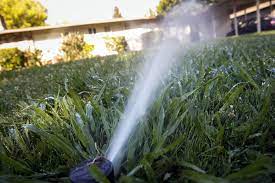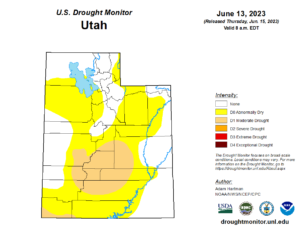
The Ultimate Guide to Watering Your Utah Lawn: Tips for Conserving Water and Promoting Healthy Growth
Having a lush and vibrant lawn in Utah requires more than just regular mowing and occasional fertilization. One crucial aspect of lawn care that often gets overlooked is proper watering. Understanding how to water your Utah lawn effectively not only promotes healthy growth but also conserves water, a precious resource in the region. In this ultimate guide to watering your Utah lawn, we will explore the essential techniques for conserving water and promoting healthy growth. From determining the ideal watering frequency to implementing water conservation strategies, we’ll provide you with the knowledge and tips you need to achieve a thriving and environmentally friendly lawn. So, let’s dive in and discover the secrets to efficient and effective lawn watering in Utah.
Understanding Utah’s Climate and Water Needs:
Utah’s climate plays a significant role in determining the watering requirements for your lawn. With its diverse landscape and varying elevations, Utah experiences a range of climates, from arid deserts to mountainous regions. This diversity means that water needs can vary significantly across the state. It is crucial to consider the specific climate zone you are in and how it impacts your lawn’s water requirements.
In Utah, several grass types are commonly found in lawns, including Kentucky bluegrass, tall fescue, perennial ryegrass, and fine fescue. Each grass type has its unique characteristics and water needs. Kentucky bluegrass, for example, is a popular choice known for its ability to withstand hot summers but requires more water than other grass types. Tall fescue, on the other hand, has deeper roots and is more drought-tolerant, requiring less frequent watering. Understanding the specific water needs of your grass type is essential for effective lawn watering.
Several factors come into play when determining the watering needs of your Utah lawn. Soil type and composition play a crucial role in water retention and drainage. Sandy soils drain water quickly and may require more frequent watering, while clay soils retain water for longer periods. Additionally, the amount of sun exposure your lawn receives affects water evaporation rates and influences the watering frequency and duration. Evaluating these factors and understanding their impact on water needs will help you tailor your watering routine for optimal results.
By considering Utah’s climate, identifying the grass type in your lawn, and assessing factors like soil type and sun exposure, you can gain a deeper understanding of your lawn’s specific water needs. This knowledge forms the foundation for implementing effective watering techniques and ensuring the health and vitality of your Utah lawn.
Recommended Watering Techniques for Utah Lawns:
Determining the ideal watering frequency for different seasons is crucial to maintaining a healthy Utah lawn. During the hot and dry summer months, lawns typically require more frequent watering to compensate for increased evaporation. As the weather cools down in the fall and spring, you can reduce the frequency of watering. However, it is essential to monitor the soil moisture levels and adjust your watering schedule accordingly to prevent under or overwatering.
Proper watering duration is key to promoting deep root growth and ensuring adequate water penetration. It is generally recommended to water your lawn deeply and infrequently. This encourages the roots to grow deeper, making the lawn more resilient to drought conditions. Aim for watering sessions that provide approximately 1 inch of water, allowing it to penetrate 6 to 8 inches into the soil. Adjusting the duration based on your grass type, soil conditions, and weather patterns will help you achieve optimal results.
Timing your watering sessions is just as important as frequency and duration. Watering during the cooler morning or evening hours is advantageous for several reasons. First, it reduces water loss through evaporation, ensuring that more water reaches the roots of your lawn. Second, it minimizes the risk of fungal diseases that can develop when grass remains wet for extended periods. By avoiding midday watering when temperatures are high and the sun is at its strongest, you can maximize the efficiency of water usage and promote healthier growth.
The sprinkler system you use and its proper adjustment play a significant role in achieving even water distribution. Consider using a sprinkler system that delivers water uniformly across your lawn. Regularly check and adjust the sprinkler heads to ensure they are spraying the right areas and not wasting water on sidewalks, driveways, or other non-lawn areas. Monitoring and maintaining your sprinkler system will help prevent water runoff and ensure that every inch of your lawn receives the necessary hydration.
By following these recommended watering techniques, you can effectively meet the water needs of your Utah lawn while conserving water and promoting healthy growth. Tailoring your watering frequency, duration, and timing to the specific requirements of your lawn will result in a lush, vibrant, and resilient landscape that thrives in Utah’s unique climate.
Water Conservation Strategies:
Water conservation plays a vital role in preserving Utah’s precious water resources and ensuring a sustainable environment. By practicing water conservation in our lawn care routines, we can contribute to the overall health of our communities and ecosystems. Conserving water not only benefits the environment but also helps lower water bills and reduces the strain on water supplies during periods of drought or water restrictions.
To reduce water usage while maintaining a healthy lawn, homeowners can implement smart irrigation technologies and techniques. Smart irrigation systems use weather sensors or soil moisture sensors to monitor the moisture levels in the soil and adjust watering schedules accordingly. This ensures that your lawn receives water only when it’s needed, avoiding unnecessary irrigation during periods of rain or when the soil is already adequately moist. Additionally, using drip irrigation in flower beds and garden areas can provide targeted water delivery directly to the roots, minimizing water waste.
Managing water runoff and preventing oversaturation are essential aspects of efficient water usage. To avoid wasting water and potential damage to your lawn, ensure that your yard has proper drainage systems in place. Redirecting rainwater away from paved surfaces and towards lawn areas can help replenish the soil’s moisture naturally. Consider incorporating features like rain gardens or permeable surfaces that allow water to seep into the ground gradually. By preventing water runoff and oversaturation, you can make the most of the water you use for irrigation and support the health of your lawn.
As we strive to maintain beautiful and healthy lawns in Utah, it’s crucial to be mindful of our water usage. By implementing water conservation strategies and adopting efficient irrigation practices, we can achieve the perfect balance between a lush lawn and responsible water stewardship. In the next section, we will explore specific techniques and considerations for optimizing water usage and promoting a thriving lawn without excessive water consumption.
Efficient Water Usage for a Lush and Healthy Lawn:
Proper lawn care practices play a significant role in maximizing water efficiency. By adopting certain techniques, you can optimize water usage and promote a lush and healthy lawn. One essential aspect is mowing at the correct height. Set your mower blade at the recommended height for your grass type to ensure optimal water retention. Longer grass shades the soil, reducing evaporation and preventing moisture loss. This encourages deep root growth and improves the lawn’s ability to withstand drought conditions.
Mulching is another effective strategy for water conservation. Applying a layer of organic mulch around plants and in garden beds helps retain moisture in the soil. Mulch acts as a protective barrier, reducing evaporation and preventing weed growth that competes for water. It also moderates soil temperature, keeping the roots cooler during hot summer months. Consider using organic materials like wood chips, straw, or compost as mulch to promote a healthy soil ecosystem and conserve water.
Monitoring and adjusting watering practices based on signs of under or overwatering is crucial for efficient water usage. Regularly inspect your lawn for indicators such as wilting, discoloration, or pooling water. These signs can help you determine whether your lawn needs more or less water. It’s important to strike a balance between providing enough moisture for your lawn’s needs and avoiding excessive watering. By making adjustments accordingly, you can avoid water waste and ensure your lawn receives the right amount of hydration.
In conclusion, proper watering techniques are essential for maintaining a healthy lawn in Utah while conserving water. By understanding Utah’s climate, grass types, and implementing the recommended watering practices, you can achieve a lush and vibrant lawn without excessive water consumption. Remember to consider the role of proper lawn care practices, such as mowing at the correct height and utilizing mulch, to maximize water efficiency. Water conservation benefits both the environment and homeowners by preserving water resources and reducing utility costs. Let’s embrace these tips and techniques, ensuring a beautiful lawn while being mindful of our water usage and contributing to a sustainable future.
